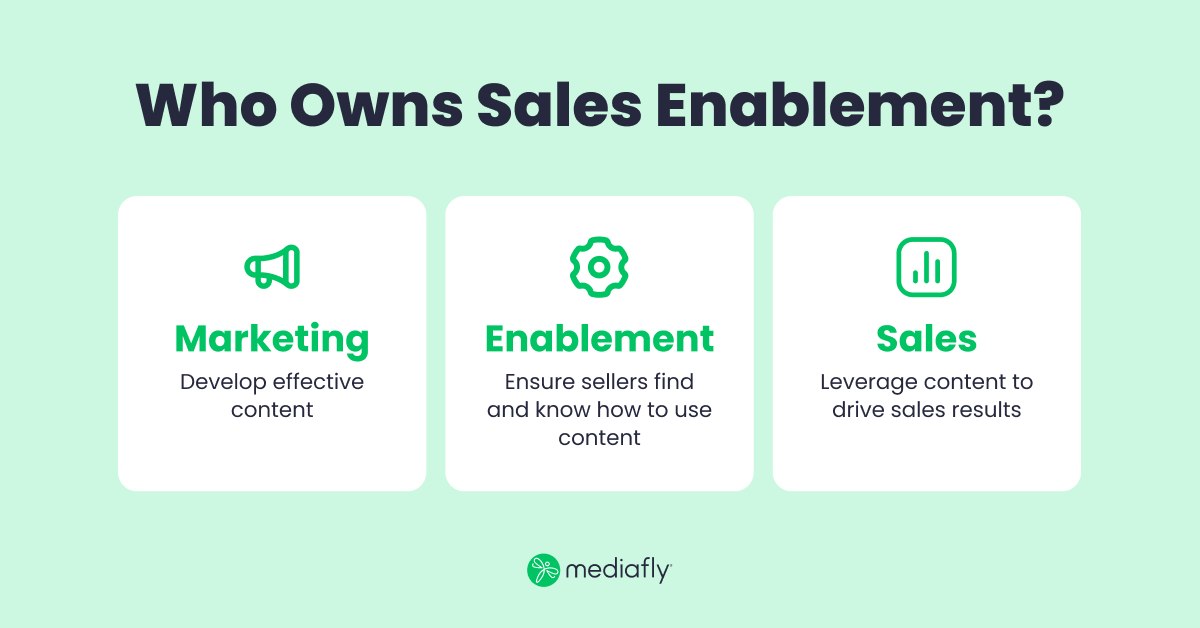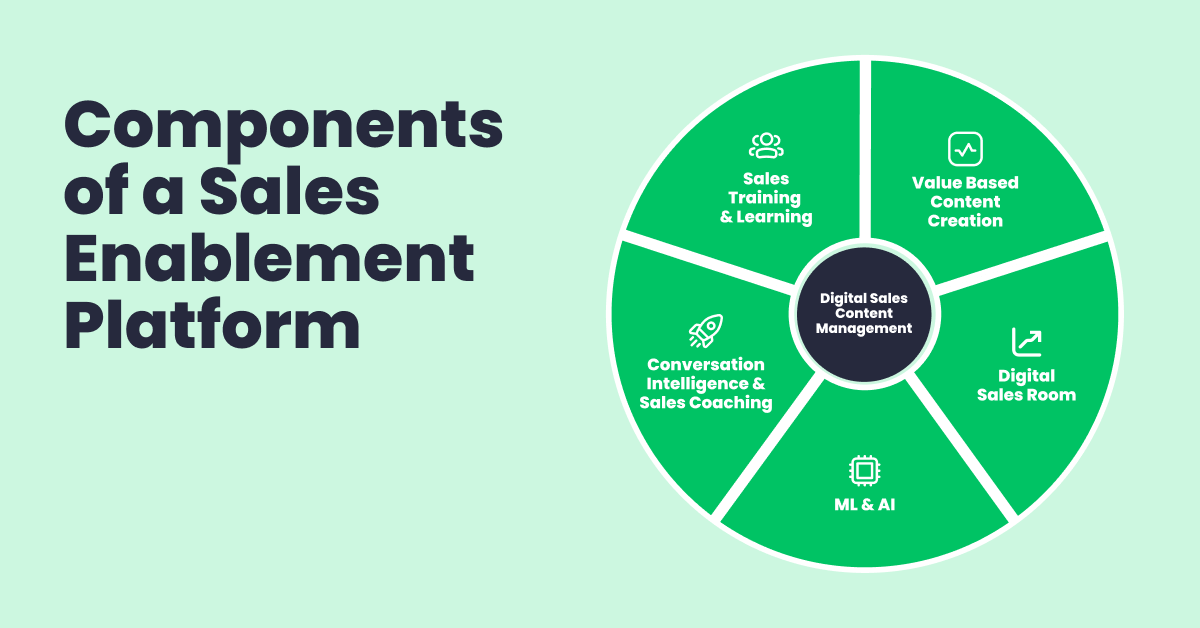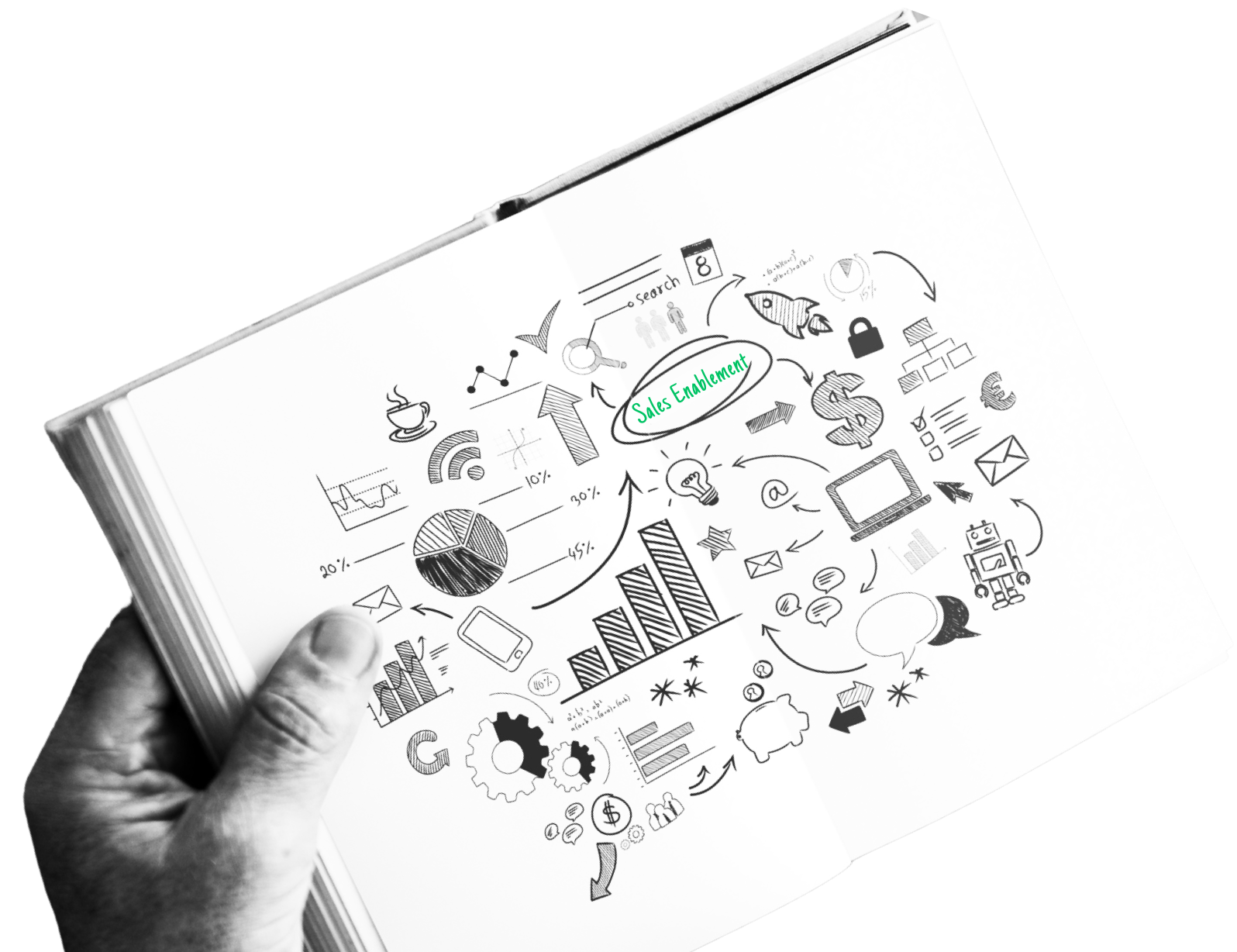In recent years, you may have noticed sales enablement emerging as a more prominent function in the business world. But, what’s all the fuss about this hot new function? Why are businesses so interested in sales-enabling technology? The short answer can be summed in one simple word: growth!
Raise your hand if you want to improve the efficiency and effectiveness of your sales reps, your customer experience, your alignment across your go-to-market teams, or your revenue growth? You can drive all of these outcomes forward by utilizing sales enablement tools and strategies.
It’s no secret that the B2B sales landscape is growing increasingly more competitive. Buyers have tons of options available to them on the market, and sellers who can’t grab a buyer’s attention with an effective value proposition have practically no chance at winning the day. Businesses looking to expand and close more deals need to have expert sellers on their side who know how to demonstrate value to the buyer at every touchpoint. And what’s the best way to turn your sales reps into a team of value experts? You guessed it – sales enablement!
You’ll find everything you need to know about sales enablement in this comprehensive guide, including what sales enablement is, why you should embrace it, who is involved, and how to make it happen at your organization. Here’s an overview of what you’ll learn:
- What is Sales Enablement?
- Why is Sales Enablement Important?
- What is a Sales Enablement Tool?
- Who Owns Sales Enablement?
- Signs You Need a Sales Enablement Strategy
- Sales Enablement Metrics: How to Measure Success
- Sales Enablement Examples: What Does Enablement Look Like in Practice?
- Sales Enablement Best Practices
- Why Now Is the Time for Sales Enablement
What Is Sales Enablement?
Broadly, sales enablement refers to an ongoing process that aims to empower commercial teams by providing them with all the resources they need to engage customers successfully and win more deals. However, when defining sales enablement in more specific terms, we must focus on the 4 key elements that make up the approach:
- Processes. Sales execution, usually informed by sales training and coaching.
- Insights. Data and analytics that provide information about what’s working and what isn’t.
- Content. Multimedia resources (including blog posts, slide decks, videos, value assessments and more) designed to engage the buyer at different touchpoints in their journey.
- Technology. The digital tools that bring it all together, gathering insights, curating and delivering content, and informing processes.


On top of these 4 elements, your company’s enablement program will also need to embrace 3 foundational principles of sales enablement:
- 1 An engaged, empowered, and supported buyer makes great purchasing decisions.
- 2 Great purchasing decisions lead to happy clients.
- 3 Happy clients are the key to increased revenue.
Once you have an understanding of these basic components, you can start developing your sales enablement strategies!
Why Is Sales Enablement Important?
Sales enablement is a necessary reaction to the increasing digitalization of the marketplace and the changing preferences of today’s buyers. Think about how you make purchases. Like most of us, your first instinct is probably to search around online, right? You start by skimming articles, blogs, and product reviews to learn more about the options available to you and narrow down your choices. Then, you run price comparisons between your choices to figure out how to get the best deal.
So… By the time you end up actually interacting with a seller, you’re already nearing the end of your buyer journey, and, chances are, you’ve already made up your mind. That means that the sales rep who helps you has barely any opportunity to make a tangible impact on your buying decision.
Now, let’s compare this modern scenario to how our grandparents used to go about buying something. Like us, they started out with some idea of what they wanted, like the make and model of a car. But they wouldn’t arrive at the dealership fully armed with data about fuel efficiency, safety features, repair costs, etc. Only today’s buyers have ready access to that amount of information about the product they want. Our grandparents would wind up making their choice based almost entirely on the influence of the sales reps they interacted with at the dealership.
The key difference here is the growth of the internet. Customers used to rely solely on sales reps to inform their purchase decisions because they were the authority on the subject. Now, the internet provides easy accessibility to a plethora of information about any product on the market, restricting the ability of sales reps to impact the buying journey. Sellers have to work ten times harder to win trust from their buyers and find new ways to demonstrate their value in the buying process if they want to have any real influence over a customer’s purchase decision.
It’s easy to see why most sales teams are struggling to adapt to such a drastically different environment. According to a report published by Pavilion & Ebsta on B2B Sales Benchmarks for 2024, the performance of sales teams in the B2B landscape is less than promising, with disheartening statistics like:
- Win rates are down 18%.
- Sales cycles grew only 16%.
- Deal values shrunk 21%.
- 69% of reps missed quota.
- 44% of deals slipped or were pushed back.
In short, buyers have become more demanding, and sellers must develop new skills if they want to stand any chance at meeting those demands. As we already know, buyers complete the bulk of their journey before they ever talk to a sales rep, often gathering product information and reviewing pricing entirely on their own time. Since buyers enter the conversation with more knowledge, they now expect sellers to present them with specific information tailored to their company. In other words, they want to know how the product will solve their problems.
Buyers also have more hoops to jump through these days. With companies operating under tighter budgets, purchasing decisions have a lot more weight than they once did. A buyer will have to advocate for any new solutions, so they have to make sure that this new source of spending is fully in service of business goals.
To adapt to these changes, sales reps must learn to sell value, not just products. Chances are, buyers already have the information they need about a given product, and, if they don’t, they can easily find it. The job of the seller is no longer to provide information about the product itself, but rather about the unique value that product delivers.
Organizations often invest hundreds of hours training their sellers to be experts on their products. However, they don’t spend nearly as much time as they should helping sellers develop the acumen to understand a business. Of course, our sellers today still need to know the ins and outs of the products they sell, but, more importantly, they must be able to explain in simple terms how those products deliver value to the buyer.



Many sales reps also struggle with information overload. According to Forrester, sellers typically have more than 1,400 assets in their arsenal. While it’s great to have nuanced sales content that fits the exact needs of different buyers, leafing through pages and pages of material to find the perfect piece of content can be a huge drain on sellers’ energy. They might even wind up spending more time looking for assets than they do actually selling. Plus, without proper guidance, they could pass over an optimal piece of content and pick out less effective materials instead, weakening their value proposition for the buyer.
Sales enablement is the key to unlocking value for sellers. Enablement tools and strategies help sales reps overcome information overload and deliver value by placing the right materials in their hands that will empower them to make the greatest impact on the buyer’s journey. By enabling our sales reps, we can push past the old industry clichés and position sellers as allies and consultants who play an integral role in the buying process.
Who Owns Sales Enablement?
Is there just one sales enablement owner? If so, who is it? The first party that comes to mind for most is probably Enablement, especially for those thinking in terms of the RACI model. But the truth is, sales enablement is a team effort. The Enablement team needs support from both Marketing and Sales if they want to make sales enablement actually work.
Of course, every organization is different. The exact ownership or delegation of sales enablement tasks may vary depending on the size of the organization, the industry in which it operates, or the sales model it follows. However, there are several key players who will almost always be present in the sales enablement process. They are:
- Marketing. Responsible for developing effective content that sellers can use to win deals.
- Enablement. Responsible for managing the content provided by Marketing, making sure sellers engage with and use the content, establishing sales processes, and helping sellers train and improve.
- Sales. Responsible for improving sales results by making use of the resources and content provided by Marketing and incorporating new sales processes developed by Enablement.



With so many moving parts in the process, full ownership of sales enablement can’t rest on the shoulders of one singular team. But, Enablement does have the unique job of bridging the gap that too often forms between Sales and Marketing.
Like the peanut butter in the sales enablement sandwich, members of the Enablement team help these two interconnected functions align and work better together. Sales enablement itself hinges on the dismantling of silos that keep Sales and Marketing disjointed, helping them adopt a more collaborative approach that aids and accelerates the customer journey.
One thing that all three parties have in common is the shared responsibility of measuring the results of their sales enablement practices. Each team must keep track of their results to figure out which parts of the process work and which areas need improvement. As the cycle of creating and passing on new content continues, everyone should keep an eye out for ways to optimize the experience for all involved.
What Is a Sales Enablement Tool?
Sales enablement software is the key to bringing your sales enablement initiatives to life. These are the tools that allow you to empower your revenue-generators, especially sellers. A sales enablement platform lets you do everything from delivering content to offering feedback and coaching sessions. If you want to make sales enablement a priority among your teams, picking up one of these tools is a great place to start.
You can expect to find the capabilities listed below in any robust sales enablement solution.



Digital Sales Content Management
Efficient sales enablement hinges on seamless content management. Sales assets must be readily accessible if you want your sellers to actually take advantage of them. A sales enablement platform acts as a centralized repository for your sales content, making it easy to manage, share, and distribute content. You can even create and curate assets for both sellers and buyers directly within the solution.
Reps who travel frequently will also be excited to hear that many tools include offline and mobile accessibility as well, allowing them to access the content they need anywhere, anytime. No more going off-script or waiting until you have your laptop and a stable Wi-Fi connection to send content to a buyer. The ability to tag assets with certain identifiers and sort them for consumption by specific roles like pre-sales or technical sellers also helps streamline both the organization and retrieval of content.
And best of all, sales enablement tools provide access to comprehensive content analytics. Teams can check out different pieces of content to see how often sellers use them and how engaging they are for buyers. Are sellers leveraging the new deck you just rolled out? Is the new deck helping them close more deals? You can find the answers to these questions and so many more about consumption patterns, asset utilization, and revenue, all within one platform.
Value-Based Content Creation
As we know, the landscape of B2B sales depends on selling value more than selling products. Buyers need to see the value your product will bring to their business demonstrated or explained in a tangible way. Luckily, your sales enablement solution can help you out with that too.
Sales enablement platforms often contain value-based selling tools like ROI and TCO calculators. These empower your sellers to deliver easily digestible, credible figures personalized for each customer. Customers can then visualize the value your product will provide based on that concrete evidence.
You can use value-based selling tools to:
- Make a value proposition to prospective buyers with little to no effort by including self-service tools on your website.
- Provide an immediate customized demonstration of value to a customer during a meeting.
- Prove realized value to existing customers come renewal time.
Sales Training and Learning
Your sellers can only be as good as the training they receive. Without access to the right materials, they might not rise to their full potential. Or worse, they could end up completely misunderstanding the company’s sales strategy, leading to a disastrous sales record.
Enable your sellers to perform to the best of their ability by providing them access to training and learning materials within your sales enablement platform. Whether you choose to store materials directly in the system or integrate with formal LMS tools, you can support the onboarding and continued education of your sales teams. Sellers will be able to gain a better understanding of their customers, follow the sales process more closely, make better use of sales materials, and easily locate any refreshment resources they may need in the moment.
Conversation Intelligence and Sales Coaching
After training comes coaching. Even the best sellers can benefit from upskilling, reskilling, or just reinforcing existing skills through helpful exercises. Sales enablement solutions allow sellers and their enablement teams to record and transcribe calls, then conduct modeling and analysis on those transcripts to generate information about each seller’s performance. Those insights can later be used as a springboard for sales coaching.
Coaching is a great way to drive long-term behavior change among sellers. By analyzing conversations from a variety of scenarios, including peer-to-peer, manager-to-seller, and seller-to-manager, members of the enablement team can pick out behaviors that drive sales and identify opportunities to help sellers build their conversational intelligence. Over time, they will gain a better understanding of each employees’ strengths and weaknesses and use that knowledge to coach them toward peak performance.
Digital Sales Rooms
We’re living in the era of digital sales, and sellers need to be ready to accommodate the needs of buyers who can’t (or won’t) meet up in person. Sales enablement software offers digital workspaces where selling teams can work directly with customers both during and after a sale. Each personalized microsite can be branded to an individual customer, creating a safe hub for bidirectional content sharing and collaboration.
Analytics and Engagement Data
Your sales enablement solution gives you a window into a number of important metrics, including platform usage and buyer engagement. Learn how well different sales assets capture the attention of your buyers by tracking how they interact with the content. Analytical tools let you see how many times buyers opened or shared a piece of content and how long they spent viewing it. Data can also help tell the story of your enablement strategies, measuring how different initiatives impact revenue performance, deal velocity, and pipeline performance.
Machine Learning and AI Capabilities
Propel your reps into the modern age of sales with a sales enablement solution that includes AI functionalities. By analyzing the activities of both buyers and sellers during a deal, AI tools can discern patterns and preferences and use those insights to guide sellers in the right direction. They may recommend the next action to take or offer up the perfect content suggestion. These tools can help sellers optimize every interaction with their customers, ultimately leading to more wins.
Key Integrations
Already got a hefty tech stack? Don’t worry – sales enablement solutions can slot right in without much hassle. Most platforms can easily connect with the following systems:
- Training and coaching platforms (i.e. a conversation intelligence provider or learning management system)
- Content management systems (i.e. Sharepoint or a DAM)
- CRM tools
- Marketing automation tools
- Revenue intelligence tools
Whether you need a lot of integrations or none at all, a sales enablement platform fits into practically any sales tech stack.
Signs You Need a Sales Enablement Strategy
By now, we know that sales enablement solves many big picture issues, like alignment between sales and marketing teams and overall performance improvement. But, if you’re still on the fence about whether or not your organization needs sales enablement, here are some of the tell-tale signs that you’re ready for a sales enablement strategy.



1. Our Sellers Can’t Find Sales Content
When sellers can’t find the content they need, it’s usually a sign that the team lacks a single source of truth for sales content. For many organizations, the root of the struggle is that they house their content in different places. You might use Sharepoint for this piece and Google Drive for another piece. Unfortunately, this means that sellers have no idea where to look. They don’t want to spend 30 minutes searching around, so they resort to their own devices instead.
If your marketing team constantly gets requests for new content that already exists, that’s another indicator that your sellers aren’t utilizing everything available to them because they can’t find it! This creates a situation where sellers go rogue. They may create their own materials or frankenstein together different pieces of content they’ve seen work in the past, resulting in a skewed asset that most likely doesn’t align with your current brand messaging.



2. Our Sellers Use Outdated or Off-Brand Content
Organizations that struggle with the first issue of sellers not being able to find content probably encounter this problem as well: sellers using outdated or off-brand content. When content is hard to find, sellers often download and save sales assets to their desktops for easier access. While this can be an efficient time-saver for them, it poses a huge risk to effective marketing because brand messaging changes fast to meet the demands of the market, and your content has to keep up!
Sellers using outdated content results in a variety of problems. For example, let’s say you had a product recall. If the content being circulated still promotes the recalled product or fails to update buyers on the issue, it can lead to confusion, frustration, and erosion of the client’s trust in the reliability of your business.
Outdated content can also be detrimental to trade promotions, which rely heavily on accurate and up-to-date information to effectively promote products. Chances are, your old sales content doesn’t reflect the current features, pricing, or availability of the products in question. Once again, this disrupts the sale and may even diminish the buyer’s confidence in the purchase.



3. We Don’t Know What Works and Why
Marketing teams pour a ton of time into creating the best sales content. The only problem is… It’s impossible for them to know what’s actually impacting sales and optimize their content accordingly without access to comprehensive analytics about sales outcomes.
The same goes for sales teams! It’s impossible for them to identify areas for improvement if they can’t see how they’re performing. Sales enablement reports are a necessary tool for both teams to be able to develop better sales strategies based on real data.



4. It Takes Too Long to Onboard Sellers
Sales enablement challenges can also pop up during the seller onboarding process. After all, when it comes to onboarding, time is money. Reps need to learn what they’re doing as fast as possible so they can start earning revenue for the business. Otherwise, they’re taking up company resources without really giving anything back.
If it takes a while for your new sales hires to become productive or grasp essential product knowledge and sales techniques, it’s probably time to improve your onboarding processes and training programs with a sales enablement solution.
Sales Enablement Metrics: How to Measure Success
It’s impossible to effectively manage what you don’t measure. So, the decision to invest in a sales enablement program must come with a way to track your progress and make sure the program drives tangible success for your teams. Plus, measuring the performance of your enablement program allows you to easily identify areas for improvement and demonstrate the impact of your efforts to management.
But, all this begs the question: What sales enablement metrics should you track? As with anything, the answer depends on your organization and the goals you have in mind for your team. However, there are a few common sales enablement KPIs you can follow to get started.
1. Sales Effectiveness Metrics
Sales effectiveness metrics measure the efficiency and success of sales activities in achieving your team’s desired outcomes. Examples include:
- Win rate. The percentage of deals won out of the total number of deals pursued.
- Average deal size. The average value of a closed deal. Typically tracked over time against an established baseline value.
- Sales cycle length. The average time it takes your team to close a deal.
- Customer lifetime value. The total revenue a customer generates for your business throughout their journey with you.
2. Sales Enablement Content Metrics
Sales enablement content metrics assess the performance and impact of different pieces of content on sales results, helping teams discover what works and use that knowledge to optimize future assets. Examples of these metrics include:
- Content engagement. How often reps and buyers access content.
- Content effectiveness. How the content impacts close revenue.
3. Technology Adoption
Measuring technology adoption means evaluating the level of acceptance, utilization, proficiency, and performance of new solutions and tools within your organization. These metrics are essential because, if tools go underutilized, you’re going to end up wasting money.
Examples of KPIs associated with tech adoption include:
- Platform usage. Check to make sure reps access content in the sales enablement app.
- Platform satisfaction. Verify that your sales team loves the tool and will continue to use it.
Sales Enablement Examples: What Does Enablement Look Like in Practice?
To paint a more vivid picture of what sales enablement looks like in action, let’s examine how it works in the context of 3 different case studies.
Trinchero
Trinchero Family Estates, a leading global player in the wine industry, found themselves face-to-face with a challenge many businesses can relate to: scattered data. With data scattered across 8 different systems, it became difficult for Trinchero to make sure that sales and marketing efforts stayed in alignment. As a result, their sales reps ended up spending way too much time (40 to 60 hours per month) searching for and adapting content, while the marketing team had no idea what was being used and what wasn’t.
To solve these issues, Mediafly created a centralized hub that both marketers and sellers on Trinchero’s team could use to manage all things content. Now, sales reps can easily find the content they want. The application even sends pertinent content suggestions based on the deals sellers are working and the buyers they are talking to.
Huntsman
Huntsman Corporation, a global chemicals company, noticed that their sales reps were struggling to find relevant content to share with buyers. Their specialized sales reps in particular only had access to content supporting their business line, making it harder to cross-sell into existing accounts and resulting in missed sales opportunities.
The global project team at Huntsman Advanced Materials released a new sales application powered by Mediafly content management as a solution. The application makes it easy for sellers to search through all product content, meaning sellers can pivot to address anything buyers want to learn more about. This shift helps drive the ability for specialized reps to cross-sell into other product lines in real-time, ensuring that there are no more missed chances.
Sealed Air
After years of utilizing 2 different sales enablement platforms (Mediafly and Showpad), Sealed Air, a provider of innovative packaging and container solutions, made the decision to consolidate platforms across the organization. They had 3 main objectives in mind:
- Improve strategic account engagement.
- Move from pitching products to selling value.
- Promote new initiatives and enable sales growth.
Sealed Air ended up selecting Mediafly and, in just 6 weeks, successfully merged 4 independent libraries from Showpad into one consolidated library in Mediafly. In the first 2 months after launch, Sealed Air experienced 90% adoption among users, a 13% increase in engagement per user, as well as more widespread adoption across the organization than it did with its previous sales application.
Key Takeaways
All of these organizations have one thing in common: They started with sales content management. This is because content and content management sit at the heart of good sales enablement. When you make content easier to find, you make your reps more productive. And, since time is money, that’s an incredible gift.
Notice that each of these organizations also achieved high adoption rates with their tools. That’s another key to their success because, as great as sales enablement tools are, they can only be truly effective if your team actually uses them.
Sales Enablement Best Practices
Best practices for any business initiative typically revolve around 3 points: people, processes, and technology. Sales enablement is no exception! Let’s examine 4 sales enablement best practices you can incorporate in your teams to cater to your own unique people, processes, and technology, thus maximizing the impact of enablement on your organization.
Calm the Chaos of Sales Enablement Content
After your product, content is the most valuable thing your organization produces. In fact, content may even be more valuable than your product because, without informative content, no one would know anything about your product.
From web pages to brochures to slide decks and everything in between, content is how you generate awareness among buyers and build familiarity with your product. Chances are, the business case that illustrates exactly why buyers need your solution – and need it now! – is probably made up of your sales content. In a word where buyers do most of their decision-making before ever engaging with a sales rep, content helps buyers visualize:
- The need your product fulfills.
- How your product works.
- How your product is different from similar products in the market.
- Why they should buy from you in place of someone else.
Since your content is your biggest advocate, it only makes sense to create content for every stage of the customer journey, from initial discovery to final decision and beyond. As the customer progresses through each stage, this content should continuously provide them new, personalized value. As you develop the content that provides that value, keep the buyer persona in mind and remember that, these days, it’s rarely just one individual we’re dealing with; now, most buyers are a growing group of decision-makers that include high-level C-Suite perspectives and end-user input.
So, we know content should be tailored to the buyer persona. But, that’s easier said than done, especially when you have a lot of information you want to communicate. The question becomes “What exactly should we write about?” A great way to narrow in on the most important points is to base your content directly on the questions buyers ask. In other words, create content that answers every question your buyers ask.
Your content should show that you understand buyers’ needs and can meet them. Content that strictly talks about how amazing your product is won’t cut it. Every question deserves an answer, and the more answers you provide, the better equipped your buyer will be to make a decision. What’s more, establishing your organization as a reliable source of information helps you win buyers’ trust and become their preferred seller.
If you’re having trouble creating sales enablement content that answers buyer questions, try tapping into value selling tools like ROI calculators, TCO comparisons, and business value assessments. These can help you create new forms of content that empower sellers to actively demonstrate the value your product will bring to the buyers’ business rather than focusing entirely on the product itself.
Lead with Value and Build Business Cases
When you think of sales content, what’s the first thing that comes to mind? Sales presentations, videos, 1-pagers? Maybe even brochures and spec sheets? While these are important assets, one content format has emerged as arguably the most important of them all: the business case.
In a recent webinar, Doug May, SVP of Productivity at Harness, summed up the necessity of value-selling, especially in the context of an ever-changing economic climate: “There have been times of great richness and wealth and times of real tight budgets — I’ve sold through all of them successfully. If you leverage this value-selling method, you don’t have to worry about the economy because you’re always attaching to one of the top 3 [business initiatives] for my customer. And, as a result of that, I’m sort of recession proof.”
To embed value-selling into your sales enablement process, you need to use tools that create value-based content. From simple discovery tools that unearth important information about the buyer to QBR decks that show existing customers how much value they’ve already received from your products, value-selling technology empowers sellers to provide new value to buyers in every interaction. And, as you gather data from these tools, you gradually compile a compelling business case that will win over the C-suite no problem.
On top of technology, today’s sellers also need to develop new skills if they want to sell value effectively. They must be able to understand and discover a company’s biggest challenges or top business priorities and actively demonstrate how their solutions solve those issues. Value-selling requires a shift in sales culture that may be met with resistance due to low seller adoption, limited resources, inadequate tools, or lack of executive buy-in. However, with the right amount of investment and reinforcement, the impact of this shift will be huge.
Create a Cycle of Continuous Sales Coaching
Unfortunately, having the right tools, people, and content alone won’t necessarily guarantee the success of your sales enablement program. It can all fall apart without effective, ongoing sales coaching. But, behavior change is hard. Human beings are creatures of habit, and pushing them to change the way they do things doesn’t always go over well. If you want your sellers and managers to adapt to changes and be held accountable for their implementation of those changes, you will need buy-in from sales leadership.
Leadership teams help ensure that the processes and practices established as part of the sales enablement program are actually put into action at the field level. Anything from listening to calls to providing training on new tools can help sellers understand that they have to take these changes seriously and apply them wherever possible. In fact, according to Mediafly’s State of Revenue Enablement Report, “High-performing organizations are 10% more likely than low-performing organizations to use conversation intelligence data to better understand their buyers, competitive dynamics, and effectiveness of their sellers.”
Leverage the Right Sales Enablement Tools to Make Outsized Impact
When you also add the right technology to your sales enablement equation, you can make 1+1=3. Sales enablement tools eliminate many of the common obstacles that stand in the way of effective value-selling, including lack of accessibility, synchronicity, or integration.
Having good content is one thing. Making it accessible to the buyers and sales reps who need it is something else entirely. But, that accessibility is arguably more important than the content itself because what good can even the best content in the world do if it’s locked behind closed doors?
If you’ve ever used a content repository like SharePoint or Box to share documents, you’ll know how easily your files can fall into disarray. Without proper visibility and communication, everyone ends up working with different versions or simply creating new copies to suit their needs. The result is a Frankenstein mess of conflicting styles and tones, outdated information, incorrect branding, and miscommunication.
Sales enablement software helps prevent this problem by creating a unified source of truth for sellers. In the platform, marketers control the source documents, while sellers flexibly create personalized content collections or customize presentations to suit their specific buyers. Many tools also provide content engagement analytics that help both marketers and sellers learn what works and what doesn’t. Insights about how content is shared, including which assets, when, and with whom, allow marketers to invest time in creating content that actually drives sales.
Speaking of wise time investments, have you ever found your sellers re-entering the same information across various applications? Or worse, entering the information inaccurately and then taking action based on that bad data? The lack of synchronicity between tools is a major obstacle to success for sales enablement strategies. Luckily, a sales enablement platform often offers integrations that make it possible to unify your tech stack and resolve these issues.
Having a fully integrated tech stack also allows you to improve the revenue team’s ability to:
- Manage and forecast your pipeline.
- Identify risk in time to save a deal.
- Determine the next best sales action.
- Develop effective sales coaching and best practices.
- Improve win rates.
Why Now Is the Time for Sales Enablement
So, why should you invest in sales enablement now? The reality is that B2B buying and selling is not going to get any easier. As we speak, the world of B2B commerce is being reshaped by digital natives, AKA Gen Z and Millennials.
Our State of Revenue Enablement report shows that Gen Z and Millennials now make up 60% of professionals in revenue roles. There’s a strong likelihood that the profile of your buyers is the same. The report also predicts that:
- Buyer-seller interactions will predominantly take place in digital formats.
- Buyers will continue to acquire information away from sellers.
- Buyers will expect seamless, personalized experiences from suppliers.
- Tech-enabled sales teams will be smaller and more productive.
That last prediction may seem alarming, but sales leaders are already having to do less with more and try to make an outsized impact using limited resources. The rise of technology like GenAI promises a better future for sales teams plagued by these issues, but only for organizations that have done the work to establish a solid foundation in technology.
In fact, early technology adopters have already started to see how sales enablement can expand into revenue enablement. There is immense value to be found in giving every customer-facing role in your organization the tools they need to best support your customers. With those tools in hand, everyone works in harmony to provide a 360-degree view of the customer that makes value-selling, and thus winning more deals, so much easier.

